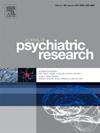应用非侵入性脑刺激技术减少愤怒和暴力倾向:一项系统回顾和荟萃分析的结果
IF 3.7
2区 医学
Q1 PSYCHIATRY
引用次数: 0
摘要
自 20 世纪 90 年代以来,评估应用非侵入性脑部刺激(NIBS)治疗耐药抑郁症患者效果的出版物数量不断增加。这包括在头骨表面施加磁场或电流,以影响大脑皮层的表层神经元。由于有证据表明这类患者的症状(如易怒或敌意)会减轻,因此使用这种技术来减轻消极情绪(包括愤怒状态)的患者越来越多。愤怒状态的减轻也有助于减少其他问题,如暴力倾向。从这个意义上说,易暴力倾向者的愤怒状态可能会受到前额叶皮质(PFC)兴奋性干扰的影响,而前额叶皮质是负责行为调节的关键脑区。因此,我们按照系统综述和荟萃分析首选报告项目(PRISMA)标准进行了系统综述和荟萃分析。在初步确定了 2426 个资料来源后,我们最终将总共 69 篇出版物纳入了系统综述,其中 45 篇用于荟萃分析。其中只有少数文章强调,在常模和临床样本中,与接受假刺激的参与者相比,使用 NIBS 技术对 PFC 的不同区域进行刺激对减少愤怒状态或暴力行为有显著作用。此外,比较对前脑功能区多个区域进行真实刺激的组别与接受假刺激的组别之间的效应大小,也没有发现在减少愤怒状态或暴力方面存在显著差异。此外,尽管大多数研究的结论是一致的,但不同研究在某些前脑功能区方面存在相当大的异质性,这可能是由于采用的 NIBS 类型造成的。因此,除非在特定情况下,否则应谨慎使用刺激前脑功能区的表面刺激作为减少暴力倾向的一般工具。本文章由计算机程序翻译,如有差异,请以英文原文为准。
The application of non-invasive brain stimulation techniques to reduce anger and violence proneness: Results of a systematic review and meta-analysis
Since the 1990s, there has been a rise in the number of publications assessing the effects of applying non-invasive brain stimulation (NIBS) to treat patients with drug-resistant depression. This involves applying magnetic fields or electrical currents to the surface of the skull to influence the superficial neurons in the cerebral cortex. Due to the evidence regarding symptom reduction in these types of patients, such as irritability or hostility, there was a rise in the use of this technique to reduce negative mood, including anger state. This decrease in anger state could also help reduce other problems such as violence proneness. In this sense, the anger state of individuals who are prone to violence might be affected by interfering with the excitability of the prefrontal cortex (PFC), a key brain region responsible for behavioral regulation. Thus, we conducted a systematic review and meta-analysis following the Preferred Reporting Items for Systematic Reviews and Meta-Analyses (PRISMA) criteria. After initially identifying 2426 sources, we eventually included a total of 69 publications for the systematic review, from which 45 were employed for the meta-analysis. Only a few of them highlighted a significant contribution of using NIBS techniques on different regions of the PFC to reduce anger state or violence when compared to participants receiving sham stimulation in normative and clinical samples. Furthermore, the comparison of effect sizes between groups that received real stimulation on several regions of the PFC and those that received sham stimulation did not reveal a significant difference in reducing anger state or violence. In addition, despite most of the conclusions being consistent, considerable heterogeneity existed across studies regarding certain PFC regions, which could be explained by the type of NIBS employed. Therefore, using superficial stimulation over the PFC as a general tool for reducing violence proneness should be approached with caution, except in specific cases.
求助全文
通过发布文献求助,成功后即可免费获取论文全文。
去求助
来源期刊

Journal of psychiatric research
医学-精神病学
CiteScore
7.30
自引率
2.10%
发文量
622
审稿时长
130 days
期刊介绍:
Founded in 1961 to report on the latest work in psychiatry and cognate disciplines, the Journal of Psychiatric Research is dedicated to innovative and timely studies of four important areas of research:
(1) clinical studies of all disciplines relating to psychiatric illness, as well as normal human behaviour, including biochemical, physiological, genetic, environmental, social, psychological and epidemiological factors;
(2) basic studies pertaining to psychiatry in such fields as neuropsychopharmacology, neuroendocrinology, electrophysiology, genetics, experimental psychology and epidemiology;
(3) the growing application of clinical laboratory techniques in psychiatry, including imagery and spectroscopy of the brain, molecular biology and computer sciences;
 求助内容:
求助内容: 应助结果提醒方式:
应助结果提醒方式:


